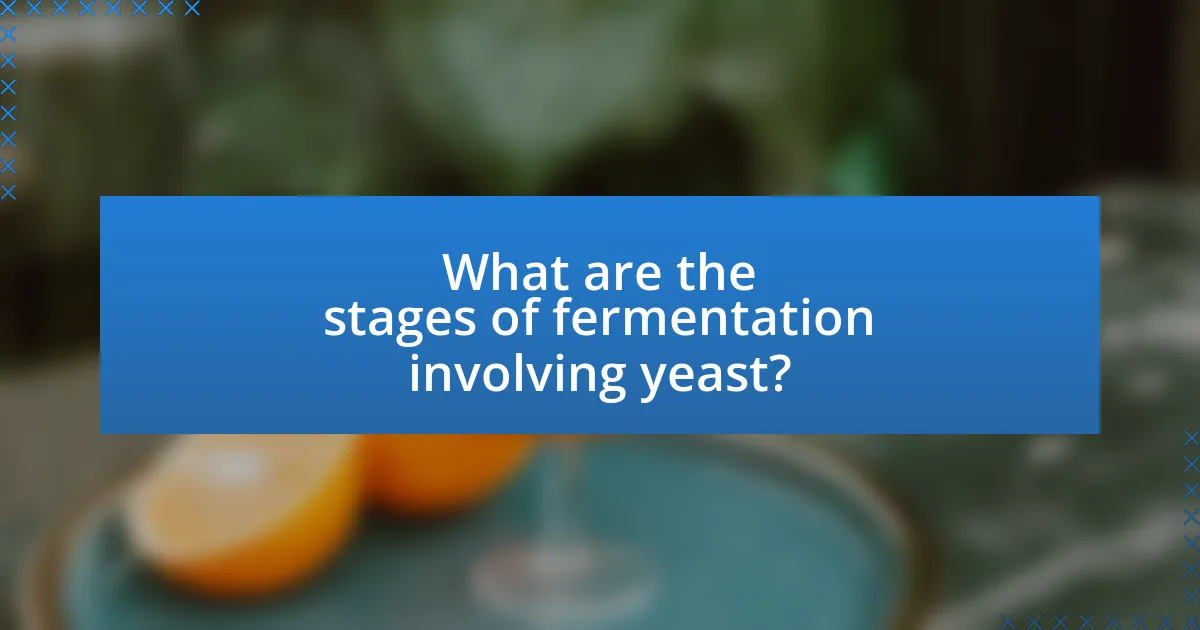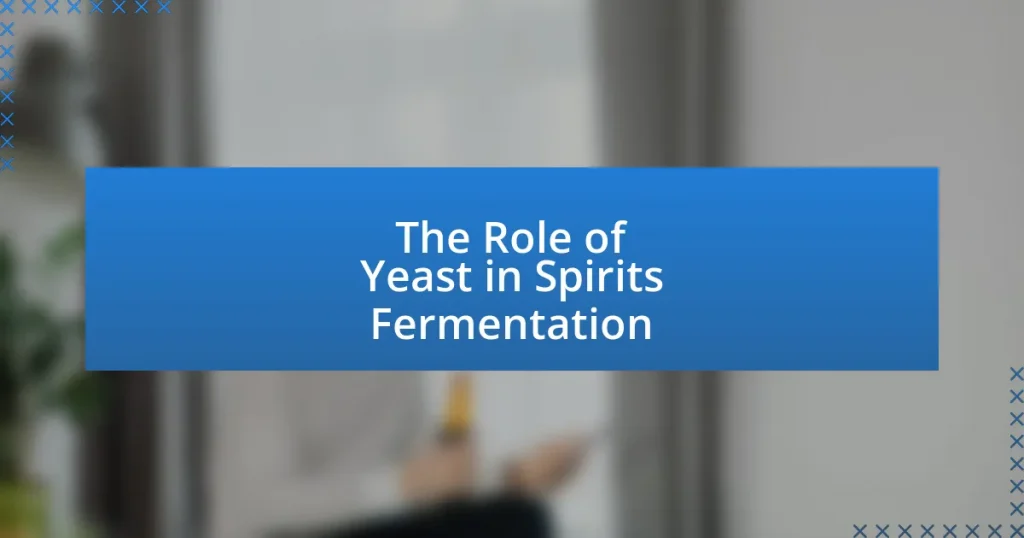Yeast plays a vital role in spirits fermentation by converting sugars into alcohol and carbon dioxide through anaerobic respiration. The article explores the fermentation process, highlighting the significance of yeast strains, particularly Saccharomyces cerevisiae, in determining the flavor profile and alcohol content of spirits. It discusses the stages of fermentation, factors influencing yeast selection, and the impact of yeast health on fermentation outcomes. Additionally, the article addresses challenges faced during fermentation and best practices for optimizing yeast performance, providing a comprehensive understanding of yeast’s essential function in the production of alcoholic beverages.

What is the role of yeast in spirits fermentation?
Yeast is a crucial microorganism in spirits fermentation, primarily responsible for converting sugars into alcohol and carbon dioxide through the process of fermentation. During this process, yeast metabolizes the sugars present in the fermentation substrate, such as grains or fruits, producing ethanol, which is the primary alcohol found in spirits. This fermentation process typically occurs under anaerobic conditions, where yeast thrives and efficiently converts sugars into alcohol, contributing to the overall flavor profile and alcoholic content of the final spirit. The specific strains of yeast used can also influence the aroma and taste characteristics of the spirit, highlighting the importance of yeast selection in the production process.
How does yeast contribute to the fermentation process?
Yeast contributes to the fermentation process by converting sugars into alcohol and carbon dioxide through anaerobic respiration. This biochemical reaction is essential in the production of alcoholic beverages, as yeast consumes the sugars present in the substrate, such as grains or fruits, and produces ethanol, which is the primary alcohol in spirits. The process also generates carbon dioxide, which can contribute to the carbonation in certain beverages. The specific species of yeast commonly used in fermentation, Saccharomyces cerevisiae, is known for its efficiency in this conversion, with studies showing that it can ferment sugars at a rate of up to 20 grams per liter per hour under optimal conditions.
What types of yeast are commonly used in spirits fermentation?
Saccharomyces cerevisiae is the most commonly used yeast in spirits fermentation. This yeast species is favored for its ability to efficiently convert sugars into alcohol and carbon dioxide, making it ideal for producing various spirits such as whiskey, vodka, and rum. Additionally, other yeast strains like Saccharomyces pastorianus and wild yeasts, including Brettanomyces, may also be utilized for specific flavor profiles and fermentation characteristics in certain spirits.
How does yeast metabolism affect alcohol production?
Yeast metabolism directly affects alcohol production by converting sugars into ethanol and carbon dioxide through fermentation. During this anaerobic process, yeast cells utilize enzymes to break down glucose and other fermentable sugars, resulting in the production of ethanol, which is the primary alcohol in alcoholic beverages. Research indicates that Saccharomyces cerevisiae, the most commonly used yeast in fermentation, can produce up to 15-20% alcohol by volume under optimal conditions. This metabolic pathway is crucial for the brewing and winemaking industries, as the efficiency of yeast in converting sugars to alcohol determines the final alcohol content of the product.
Why is yeast selection important in spirits production?
Yeast selection is crucial in spirits production because it directly influences the fermentation process, flavor profile, and overall quality of the final product. Different yeast strains have unique characteristics, such as fermentation speed, alcohol tolerance, and flavor compound production, which can significantly affect the taste and aroma of the spirit. For instance, Saccharomyces cerevisiae is commonly used for its efficiency in converting sugars to alcohol and producing desirable esters and phenols that enhance flavor complexity. Studies have shown that specific yeast strains can produce varying levels of congeners, which are compounds that contribute to the spirit’s aroma and taste, thereby impacting consumer preference and marketability.
What factors influence the choice of yeast strain?
The choice of yeast strain is influenced by factors such as fermentation temperature, desired flavor profile, alcohol tolerance, and the specific substrate being fermented. Different yeast strains exhibit varying characteristics; for instance, some strains thrive at higher temperatures, which can affect the fermentation speed and flavor development. Additionally, certain strains are selected for their ability to produce specific esters and phenols that contribute to the aroma and taste of the final product. Alcohol tolerance is also crucial, as some strains can withstand higher alcohol concentrations, which is essential for spirits production. Finally, the type of raw materials, such as grains or fruits, can dictate the most suitable yeast strain to optimize fermentation efficiency and flavor outcomes.
How does yeast impact the flavor profile of spirits?
Yeast significantly impacts the flavor profile of spirits by producing various compounds during fermentation, including esters, phenols, and higher alcohols. These compounds contribute fruity, floral, and spicy notes to the final product. For instance, specific yeast strains can enhance the aroma of whiskey by generating vanillin, which imparts a vanilla flavor, while other strains used in rum production can produce fruity esters that give the spirit a tropical character. Research indicates that the choice of yeast can alter the sensory attributes of spirits, with studies showing that different Saccharomyces cerevisiae strains can lead to distinct flavor profiles in distilled beverages.

What are the stages of fermentation involving yeast?
The stages of fermentation involving yeast are primary fermentation, secondary fermentation, and maturation. During primary fermentation, yeast converts sugars into alcohol and carbon dioxide, typically lasting from several days to weeks, depending on the conditions and the type of beverage being produced. Secondary fermentation follows, where the initial alcohol content stabilizes, and flavors develop further, often lasting from a few weeks to several months. Finally, maturation occurs, allowing the beverage to age and enhance its flavor profile, which can take from months to years. These stages are critical in the production of spirits, as they directly influence the final product’s taste, aroma, and quality.
How does the fermentation process begin with yeast?
The fermentation process begins with yeast when it consumes sugars and converts them into alcohol and carbon dioxide through anaerobic respiration. Yeast, specifically Saccharomyces cerevisiae, is the primary microorganism used in fermentation, and it thrives in environments where sugars are present, such as in fruit juices or grain mash. During this process, enzymes produced by yeast break down complex carbohydrates into simpler sugars, which are then fermented. This conversion is essential in the production of alcoholic beverages, as it results in the desired alcohol content and contributes to the flavor profile of the final product.
What are the initial conditions required for yeast activation?
Yeast activation requires specific initial conditions, including the presence of moisture, an appropriate temperature range, and a suitable nutrient source. Moisture is essential as yeast cells need water to swell and begin metabolic activity. The optimal temperature for yeast activation typically ranges from 25°C to 30°C, as temperatures outside this range can inhibit yeast function or kill the cells. Additionally, a nutrient source, such as sugar, is necessary for yeast to produce energy and grow, facilitating fermentation. These conditions are critical for effective yeast activation and subsequent fermentation processes in spirit production.
How does yeast reproduce during fermentation?
Yeast reproduces during fermentation primarily through a process called budding. In this asexual reproduction method, a new yeast cell forms as a small protrusion on the parent cell, eventually detaching to become an independent organism. This process occurs rapidly under favorable conditions, such as the presence of sugars and optimal temperatures, allowing yeast populations to increase significantly during fermentation. Studies have shown that under ideal conditions, yeast can double its population every 1.5 to 2 hours, demonstrating its efficiency in reproduction during the fermentation process.
What happens during the active fermentation phase?
During the active fermentation phase, yeast converts sugars into alcohol and carbon dioxide through the process of anaerobic respiration. This phase is characterized by vigorous bubbling and foaming as carbon dioxide is released, indicating that yeast is actively metabolizing the sugars present in the fermentation medium. The temperature typically rises due to the exothermic nature of fermentation, and the pH may decrease as organic acids are produced. This phase is crucial for developing the desired flavor profile and alcohol content in the final spirit.
How does yeast convert sugars into alcohol and carbon dioxide?
Yeast converts sugars into alcohol and carbon dioxide through a process called fermentation. During fermentation, yeast cells metabolize sugars, primarily glucose, in the absence of oxygen, resulting in the production of ethanol (alcohol) and carbon dioxide as byproducts. This biochemical process involves enzymes that break down the sugar molecules, facilitating their conversion into alcohol and carbon dioxide. For instance, Saccharomyces cerevisiae, a common yeast strain used in brewing and winemaking, efficiently ferments sugars at optimal temperatures, typically between 20°C and 30°C. The overall reaction can be summarized by the equation: C6H12O6 (glucose) → 2 C2H5OH (ethanol) + 2 CO2 (carbon dioxide). This process is fundamental in the production of alcoholic beverages and is utilized in various fermentation industries.
What byproducts are generated during fermentation?
During fermentation, the primary byproducts generated include ethanol, carbon dioxide, and various organic acids. Ethanol is the main product of alcoholic fermentation, produced by yeast as it converts sugars into alcohol. Carbon dioxide is released as a gas, contributing to the effervescence in beverages like beer and sparkling wine. Additionally, organic acids such as acetic acid and lactic acid may form, influencing the flavor profile of the final product. These byproducts are essential in defining the characteristics of fermented beverages, with ethanol being the primary focus in spirits production.

What challenges can arise with yeast in spirits fermentation?
Challenges that can arise with yeast in spirits fermentation include contamination, temperature fluctuations, and nutrient deficiencies. Contamination by wild yeast or bacteria can lead to off-flavors and spoilage, negatively impacting the final product. Temperature fluctuations can stress yeast, resulting in incomplete fermentation or the production of undesirable compounds. Additionally, nutrient deficiencies, particularly nitrogen, can hinder yeast growth and fermentation efficiency, leading to lower alcohol yields. These challenges can significantly affect the quality and consistency of the spirits produced.
How can yeast health affect fermentation outcomes?
Yeast health significantly impacts fermentation outcomes by influencing fermentation speed, alcohol yield, and flavor profile. Healthy yeast cells are more efficient at converting sugars into alcohol and carbon dioxide, leading to a faster fermentation process. For instance, research indicates that yeast strains with optimal health can achieve fermentation completion in as little as 5 to 10 days, while stressed yeast may take much longer, resulting in incomplete fermentation and lower alcohol content. Additionally, healthy yeast produces desirable flavor compounds, enhancing the overall sensory characteristics of the final product. In contrast, compromised yeast health can lead to off-flavors, such as hydrogen sulfide, which negatively affects the quality of spirits. Thus, maintaining yeast health is crucial for achieving desired fermentation outcomes in spirits production.
What are common signs of stressed yeast during fermentation?
Common signs of stressed yeast during fermentation include sluggish fermentation, off-flavors, and increased production of fusel alcohols. Sluggish fermentation occurs when yeast fails to convert sugars into alcohol efficiently, often resulting in a prolonged fermentation period. Off-flavors, such as sour or vinegar-like tastes, can emerge due to the yeast’s inability to metabolize sugars properly under stress. Additionally, stressed yeast may produce higher levels of fusel alcohols, which are undesirable byproducts that can negatively impact the final product’s flavor profile. These signs indicate that the yeast is not functioning optimally, often due to factors like temperature fluctuations, nutrient deficiencies, or high alcohol concentrations.
How can temperature fluctuations impact yeast activity?
Temperature fluctuations can significantly impact yeast activity by affecting fermentation rates and yeast viability. Yeast, particularly Saccharomyces cerevisiae, thrives within a specific temperature range, typically between 20°C and 30°C. When temperatures drop below this range, yeast activity slows, leading to reduced fermentation efficiency and potential off-flavors. Conversely, elevated temperatures can accelerate fermentation but may also stress yeast, resulting in the production of undesirable byproducts such as fusel alcohols. Research indicates that maintaining stable temperatures during fermentation optimizes yeast performance and enhances the quality of the final spirit product. For example, a study published in the Journal of the American Society of Brewing Chemists found that temperature control during fermentation improved yeast health and overall flavor profiles in beer production.
What are the best practices for managing yeast in fermentation?
The best practices for managing yeast in fermentation include maintaining optimal temperature, ensuring proper nutrient availability, and monitoring pH levels. Optimal temperature ranges for yeast activity typically fall between 20°C to 30°C, as temperatures outside this range can inhibit fermentation or lead to off-flavors. Providing adequate nutrients, such as nitrogen and vitamins, is crucial for yeast health and fermentation efficiency, as deficiencies can result in sluggish fermentation or stuck fermentation. Additionally, maintaining a pH level between 4.0 and 4.5 supports yeast viability and metabolic activity, which is essential for producing high-quality spirits. These practices are supported by research indicating that yeast performance directly influences the flavor profile and overall quality of the final product.
How can winemakers and distillers optimize yeast performance?
Winemakers and distillers can optimize yeast performance by selecting appropriate yeast strains, managing fermentation conditions, and providing essential nutrients. Specific yeast strains are chosen based on their fermentation characteristics, such as alcohol tolerance and flavor profile, which directly influence the final product. Additionally, controlling temperature, pH, and oxygen levels during fermentation creates an environment conducive to yeast activity, enhancing fermentation efficiency. Providing nutrients like nitrogen and vitamins supports yeast health and activity, leading to a more complete fermentation process. Research indicates that optimal yeast management can improve fermentation rates and product quality, as seen in studies demonstrating that specific nutrient additions can increase ethanol yield by up to 20%.
What troubleshooting steps can be taken if fermentation stalls?
If fermentation stalls, the first troubleshooting step is to check the temperature, as yeast activity is highly temperature-dependent. Yeast typically thrives between 65°F and 75°F; temperatures outside this range can inhibit fermentation. Next, assess the specific gravity using a hydrometer to determine if fermentation has truly stalled or if it is progressing slowly. If the gravity remains constant over several days, it indicates a stall.
Additionally, ensure that there is sufficient yeast nutrient available, as a lack of nutrients can lead to sluggish fermentation. If necessary, adding yeast nutrient can help revive the process. Another step is to gently stir the fermentation vessel to re-suspend the yeast and encourage activity. If these steps do not resolve the issue, consider pitching a fresh yeast starter to re-initiate fermentation.
These troubleshooting steps are based on the understanding that yeast health and environmental conditions are critical for successful fermentation in spirits production.


